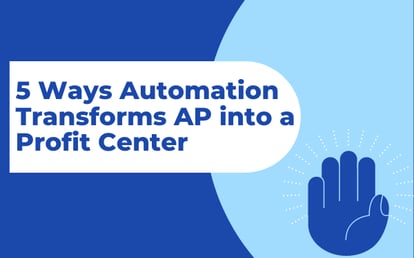5 Ways Automation Will Transform AP into a Profit Center JD Edwards EnterpriseOne
5 Ways Automation Transforms AP into a Profit Center
 So, how do you transform your accounts payable department that’s using JD Edwards ERP for processing invoices into a profit center? The accounts payable department’s standing has never been higher. Gone are the days when accounts payable was a tactical back-office function with limited strategic value for the enterprise.
So, how do you transform your accounts payable department that’s using JD Edwards ERP for processing invoices into a profit center? The accounts payable department’s standing has never been higher. Gone are the days when accounts payable was a tactical back-office function with limited strategic value for the enterprise.
Businesses are counting on accounts payable to be a partner in the coming economic recovery.
Most controllers surveyed by the Institute of Finance and Management (IOFM) rate their accounts payable department as having “high value” and being a “critical component of their business.” Another 22 percent of controllers say that accounts payable is “integral to some business units.”
What excites controllers about accounts payable is how it drives profitability.
- Lower cost of goods: Liquidity management remains a top priority for businesses. Invoice-to-pay automation facilitates dynamic discounting and supply chain financing, where suppliers exchange discounts off the invoice amount for early payment. With automation, organizations will pay a higher percentage of invoices within the early payment discount period. Organizations that take advantage of just a discount term of 1/10 net 30 earn an annualized 18 percent return. Capturing early payment discounts lowers the cost of goods.
- Reduced borrowing costs: Paying supplier invoices on time significantly improves a company’s credit rating, which can open the door to lower interest rates for borrowing.
- Enhanced working capital management: A lack of visibility into invoices and payables is the second-biggest accounts payable challenge cited by controllers. Businesses with a high level of invoice-to-pay automation have more than four times greater visibility into their overall organizational cash flow than other businesses. Invoice-to-pay solutions provide interactive dashboards with cash flow information, visibility across business units, easy access to contractual terms, and invoice tracking. Visibility into spending and cash enables businesses to make more informed financial decisions, adjust market strategies, improve operational efficiency, and streamline compliance, audit, and regulatory requirements.
- Increased margins: Businesses are challenged by tight margins and unrelenting pressure to control costs. Automation enables buyers to define business rules for invoice processing to ensure compliance with price and quantity tolerances. Automation also accelerates invoice processing, which speeds the delivery of inventory and, in turn, reduces warehouse charges.
- Cash-back rebates: Businesses can earn cash-back rebates on payments to suppliers made via card. And it’s not just small purchases that can be made via card. Many buyers make 20 percent or more of their supplier payments via card. In some cases, the rebates earned from card payments more than offset the cost of an accounts payable department’s personnel.
Businesses expect more from their accounts payable department. Automation enables accounts payable departments of all sizes to transform themselves into a strategic, profit-generating function. JD Edwards software can help address these challenges.
Want to transform your accounts payable department into a profit center? Contact us today.
